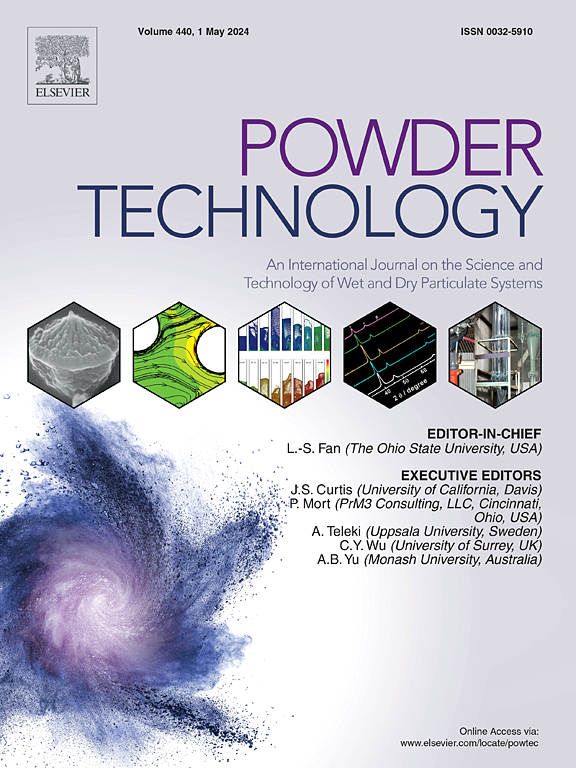优化高氧化钙(CaO)含量粉煤灰的表面改性参数以用作填充材料
IF 4.6
2区 工程技术
Q2 ENGINEERING, CHEMICAL
引用次数: 0
摘要
粉煤灰(FA)是火力发电厂将煤炭碾磨成特定尺寸后燃烧产生的细粒废料,与烟气一起进入旋风分离器或电除尘器。与所有工业废料一样,人们对利用 FA 的可能性进行了研究,它可用作水泥和混凝土的添加剂。尽管如此,全球与日俱增的工业废物带来了许多问题,尤其是环境问题。因此,人们一直在研究相关废物的其他用途。在本文中,来自土耳其阿夫辛-埃尔比斯坦的 FA 含有约 50 % 的氧化钙,在行星式研磨机中与硬脂酸一起加工,用作工业产品的填充材料,其粒度为 68.10 μm(d50),比表面积为 176.40 m2/g,接触角为 13.89。为了通过机械化学表面改性使亲水表面结构疏水,进行了优化和表征研究。同时,采用 D-optimal 实验设计优化了表面改性参数,如操作速度(转/分)、球填充率(%)、FA 填充率(%)、纸浆密度、硬脂酸用量(FA 的百分比)和改性时间(分钟)。根据最佳表面改性参数,得到了活性率为 99.70%、接触角为 95.06o、中等粒度(d50)为 10.60 μm、SSA 为 926.90 m2/g 的涂覆粉煤灰(CFA)产品。本文章由计算机程序翻译,如有差异,请以英文原文为准。

Optimization of surface modification parameters of fly ash with high calcium oxide (CaO) content to use as a filling material
Fly ash (FA) is the fine-grained waste product obtained by burning coal after being ground to specific sizes in thermal power plants, carried with flue gases, and kept in cyclones or electro-filters. Like every industrial waste, the possibilities of utilizing FA have been investigated, and it can be utilized as an additive in cement and concrete. Despite this, industrial waste, which increases daily in the world, brings many problems, especially environmental problems. For this reason, alternative usage areas of the waste in question are constantly being investigated. In this paper, FA containing approximately 50 % CaO from Afşin-Elbistan, Turkiye was processed with stearic acid in a planetary mill to be used as a filling material in industrial products, and it has a grain size of 68.10 μm on a d50 basis, a specific surface area (SSA) of 176.40 m2/g and a contact angle of 13.89. An optimization and characterization study was conducted to make the hydrophilic surface structure hydrophobic by mechanochemical surface modification. Also, surface modification parameters, such as operational speed (rpm), ball filling ratio (%), FA filling ratio (%), pulp density, stearic acid dosage (% of FA), and modification time (min.) were optimized with the D-optimal experimental design. Based on the optimum surface modification parameters, a coated fly ash (CFA) product was obtained with an active ratio of 99.70 %, a contact angle of 95.06o, a medium size (d50) size of 10.60 μm, and an SSA of 926.90 m2/g.
求助全文
通过发布文献求助,成功后即可免费获取论文全文。
去求助
来源期刊

Powder Technology
工程技术-工程:化工
CiteScore
9.90
自引率
15.40%
发文量
1047
审稿时长
46 days
期刊介绍:
Powder Technology is an International Journal on the Science and Technology of Wet and Dry Particulate Systems. Powder Technology publishes papers on all aspects of the formation of particles and their characterisation and on the study of systems containing particulate solids. No limitation is imposed on the size of the particles, which may range from nanometre scale, as in pigments or aerosols, to that of mined or quarried materials. The following list of topics is not intended to be comprehensive, but rather to indicate typical subjects which fall within the scope of the journal's interests:
Formation and synthesis of particles by precipitation and other methods.
Modification of particles by agglomeration, coating, comminution and attrition.
Characterisation of the size, shape, surface area, pore structure and strength of particles and agglomerates (including the origins and effects of inter particle forces).
Packing, failure, flow and permeability of assemblies of particles.
Particle-particle interactions and suspension rheology.
Handling and processing operations such as slurry flow, fluidization, pneumatic conveying.
Interactions between particles and their environment, including delivery of particulate products to the body.
Applications of particle technology in production of pharmaceuticals, chemicals, foods, pigments, structural, and functional materials and in environmental and energy related matters.
For materials-oriented contributions we are looking for articles revealing the effect of particle/powder characteristics (size, morphology and composition, in that order) on material performance or functionality and, ideally, comparison to any industrial standard.
 求助内容:
求助内容: 应助结果提醒方式:
应助结果提醒方式:


